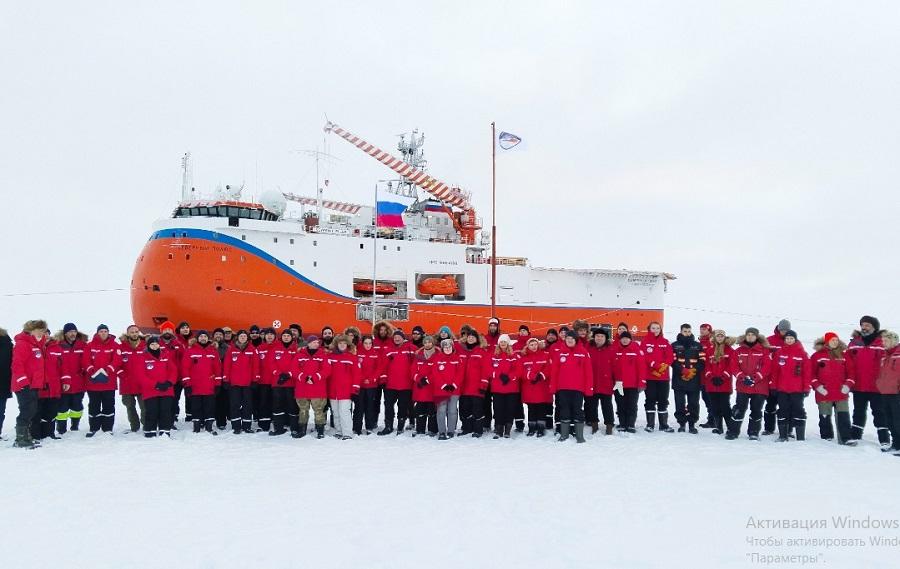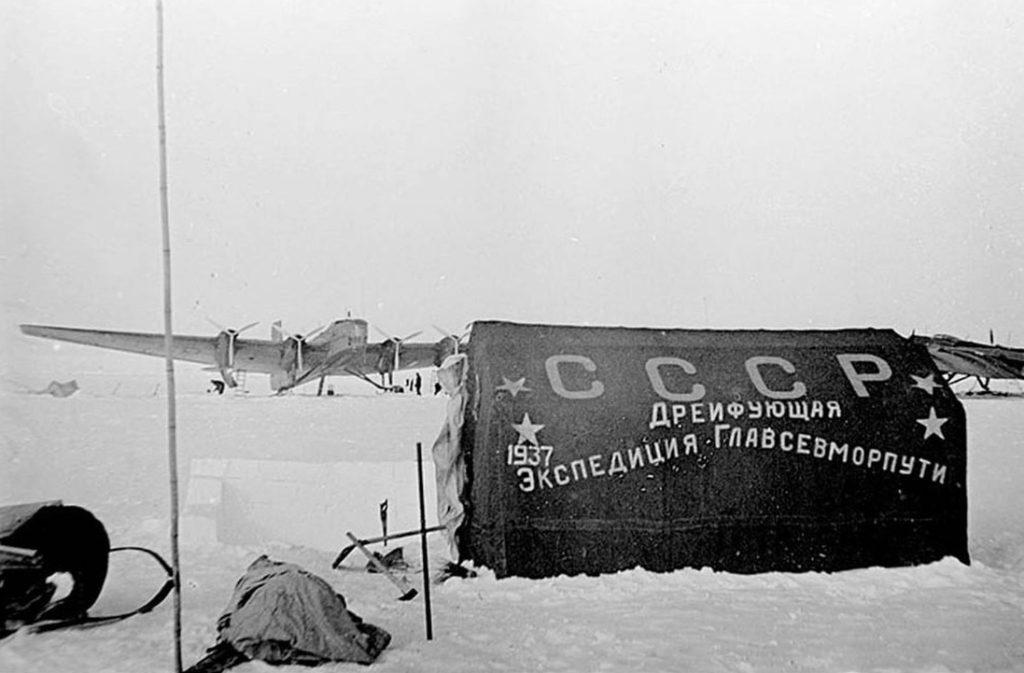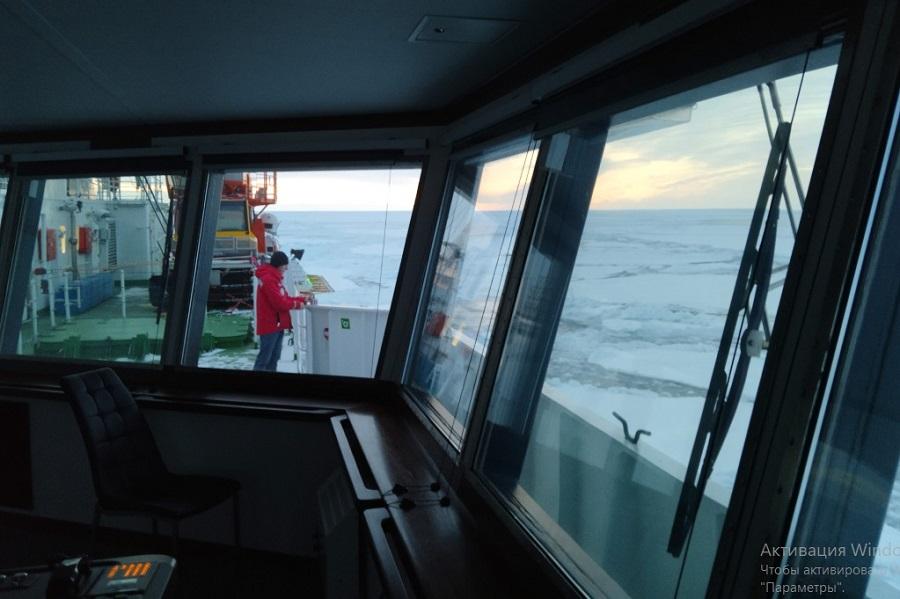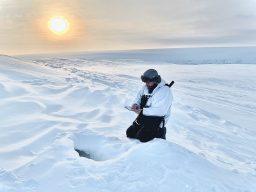
The composition of the SP-42 expedition at the opening of the ice camp. © Sergey Rybakov / TASS
Ice is alive, and fuel is life
The opening of the world’s first Soviet drifting polar station “North Pole —1” (SP-1) took place on June 6, 1937. Then the famous papanins held out on the ice floe for 274 days and, having collected the most valuable layer of scientific data, returned heroes. 87 years later, we went to the Arctic to open the drifting polar station SP-42 (the official name is the scientific expedition vessel North Pole).
The single cabin of a specially designed research vessel – an ice—resistant self—propelled platform (LSP) – has a shower, air conditioning, a work desk, and a comfortable bed. At the same time, there are thousands of kilometers of ice and nothing more behind the glass of the porthole.
Sevastopol nugget. Ivan Papanin without “bronze” and exaggerations
My thoughts are interrupted by a knock on the door — mechanics usually come to me with few words, but we kind of became friends, so I ask him to tell me what is the most important thing in conditions of prolonged drift in the Arctic.
Previously, the heart of the ice camp was always a DES (diesel power plant) – these are two generators, between which, as a rule, a sauna was placed — additional heating for the “heart”. Now the power is supplied by the LSP itself — one power cable will go to the main switchboard (GRSH), and already from it, forming a small spider web, energy will flow to all other points of the ice camp.
“Usually, the fuel is unloaded by helicopter immediately, with a large margin. Certain points are set. The ice floe can break, so there are several fuel bases that are scattered in a certain way throughout the ice field. This time it’s all in one place, on the LSP, and it makes our work incredibly easier,” says Sergey Sharonov, senior mechanic of the current SP—42 expedition, as well as a participant in the SP-40 and SP-41 expeditions.
Both then and now, fuel is the energy that ensures the operation of all electrical appliances. These are communication, research, hygiene, hot food and, of course, warmth.
In the entire history of the Arctic drifting stations, it seems that there has not been a single ice camp that would not have to be moved, sometimes to unimaginable distances. For polar explorers, this is the norm, any of them will tell you that ice is alive, it always cracks. For example, Vladimir Sokolov, who visited all Russian drifting stations (from SP-32 to SP-40), said that their ice floe broke more than 130 times on SP-30.
This crack then “breathes” — it can converge and diverge. Sergey Ovchinnikov, the leading aerologist of the SP-42 expedition, who was also on the SP-36, SP-38 and SP-40, has also seen many such faults. He told me that once they had to take boats to the galley for lunch.
“There is such a rift going on slowly, like a human step, only a hundred times more powerful — scarier than the tracks of a tank. The ice cracked — it’s like a rocket was fired. The rumble is standing, and there is an icy shaft. And it is 2-2.5 m high. And he goes to your tent, your workplace, and you’re already alone, in the dark, and there’s nothing you can do. If you stand there, you shout: “Stop… Please!” And he’s already starting to break the racks — and suddenly… stops. And it’s okay — I stepped over, went to work at the place,” he waves his arms as if he found himself there again.
The most dangerous thing is when such faults go through fuel depots, which is why the old Russian saying “Don’t put all your eggs in one basket” has been akin to the law here for a long time.
There used to be polar aviation and … dogs

A polar station on a drifting ice floe. Photos from open sources
Speaking of the joint venture, it is impossible not to mention the already mentioned high-latitude air expeditions “North”, thanks to which a powerful polar aviation existed in the USSR.
“Every year for almost four decades, the North expeditions have been working, which landed not stations for a short time by aviation, but groups of researchers who flew over vast areas in this way. Due to this, we had an idea of the state of the ice sheet and where the station could be landed,” said Kirill Filchuk, head of the SP—41 expedition.
The polar aviation operated side by side with the drifting stations — transporting people, food and medicines. In the 1990s, both the equipment and the polar pilot school itself were lost, and this is a particularly painful topic for polar explorers. The presence of an LSP does not fully compensate for this loss, but still, due to its autonomy, reduces the need for constant air supply.
Nevertheless, landing an airplane on an ice floe requires the highest skill. Not to mention how to equip a runway for this, if the ice field itself is not suitable for this? As Sergey Ovchinnikov emphasized, in the USSR the strip was made independently, and it was smooth as a hockey field, but the most difficult thing is its maintenance.
The SP-42 was not even planned for the participation of man’s best friends, dogs. As Kirill Filchuk stressed, earlier the SP-41 expedition did without them, despite the fact that it regularly encountered bears: there is a special thermal imaging radar on board the LSP and a completely different detection and warning system operates.
“This is the result of the transition to a new scheme, a new approach. It’s one thing when a camp consists of cabins, people often move around and are on the ice almost all the time. Another thing is when we are on a ship: if people go out on the ice, there is always support from the bridge — a person stands and watches what is happening from a height of more than 20 m, and during the polar night there is an opportunity to illuminate the camp. There is much less risk here,” Filchuk explained.
It still upsets many participants of the current expedition, because for them a dog is primarily not a means of safety, but a friend with whom you will not quarrel. But in the current realities of the LSP, such an approach seems to harm the dogs themselves, because in order to live in the Arctic, they need to be useful companions, and not just beloved pets.
“People are compassionate creatures, and dogs should not be allowed on the ship. In order for them to live actively and work, perform their functions, they only need to be on the ice,” Vladimir Sokolov believes.
The “New Era” and the other “league”

View from the bridge of the NES “North Pole”. © Sergey Rybakov/ TASS
During the heyday of Soviet science, drifting stations were sent almost annually — it often turned out that two such stations operated in the Arctic at once. Starting from the first joint ventures until today, the complex of studies has hardly changed, but the ice fields gradually became smaller and thinner, and the drift time was shortened.
The last full-fledged annual drifting station was SP-40, which completed its work in June 2013, and in 2015 the seasonal SP-2015 operated for four months.
They were able to revive the work of the drifting stations only by building a LSP and sending it on an expedition in 2022. Vladimir Sokolov pointed out another difference: if in the early years of the drifting stations the ice had to be at least 3 m thick, and in post—Soviet times – at least two, then the thickness of the ice floe into which the LSP-42 froze is now a little more than a meter.
“We didn’t know yet that there were active climate changes in the Arctic ocean, that we were on the border of another climatic epoch and that the ice in this era would get worse and worse,” Sokolov says about SP-30.
These changes are also well illustrated by the memoirs of the legendary polar explorer and head of the SP-3 expedition Alexei Treshnikov. At that time, the polar explorers had enough ice for an entire ice palace, built for one of the main communist holidays — May 1.
“Upon entering the house, the guests were pleasantly surprised: there are no windows, but a soft blue light flows through the walls and from below through the ice. D.I. Shcherbakov told us at the festive table: “People who managed to celebrate their favorite holiday so solemnly, beautifully and cheerfully in the kingdom of eternal ice are capable of a heroic feat,” Treshnikov wrote in the book “At the Poles of the Earth.”
…As soon as we dock, Chief Ipatov runs to the ice to help assemble the first house for meteorologists, former chief Filchuk, who volunteered to accompany the SP-42 expedition, although he stayed with his family for at most three months since the last drift of 20 months, helps with mooring — directs and shows.
“Of course, it was a different level in terms of lack of outside support, communication, navigation, etc. We are in completely different conditions, and when you think about it, you realize that although we have our own risks and difficulties, they do not stand up to comparison. It’s not that league, it’s all different — that heroic era is probably gone,” says … when we both leave the station, and it’s clear from him that he wants to stay.
By Sergey Rybakov


